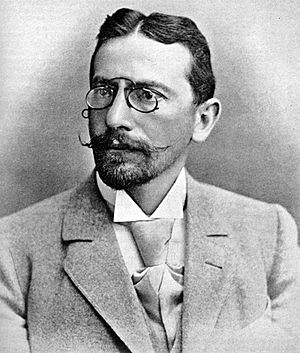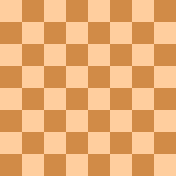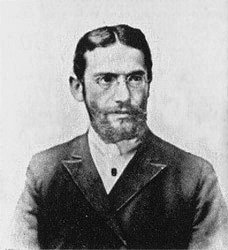Siegbert Tarrasch facts for kids
Quick facts for kids
Siegbert Tarrasch
|
|
|---|---|

circa 1900
|
|
| Born | 5 March 1862 |
| Died | 17 February 1934 (aged 71) |
| Citizenship | Prussia → Germany |
| Occupation | chess player |
Siegbert Tarrasch (born March 5, 1862 – died February 17, 1934) was a famous German chess player. Many people thought he was one of the best players and most important thinkers about chess in the late 1800s and early 1900s. He helped shape how chess was played and understood.
Contents
About Siegbert Tarrasch
Tarrasch was born in a city called Breslau. This city was in a part of Germany known as Prussian Silesia. Today, Breslau is called Wrocław and is in Poland.
After finishing school in 1880, he moved to study medicine. He went to universities in Berlin and Halle. Later, he became a successful doctor. He lived with his family in Nuremberg and then in Munich. He had five children.
His Amazing Chess Career
Siegbert Tarrasch was a medical doctor, but he was also an amazing chess player. Some people believe he might have been the best player in the world in the early 1890s. He played very well against the older World Champion Wilhelm Steinitz.
Tarrasch won four big chess tournaments in a row. These wins happened in Breslau (1889), Manchester (1890), Dresden (1892), and Leipzig (1894).
Challenges Against Champions
In 1893, Tarrasch played a tough match against Mikhail Chigorin in St. Petersburg. He drew the match, meaning it was a tie.
However, after Emanuel Lasker became the world chess champion in 1894, Tarrasch found it hard to beat him. One writer, Fred Reinfeld, said that Tarrasch was "destined to play second fiddle" to Lasker. This means Lasker was usually better when they played.
Tarrasch was still a very strong player. He easily beat Frank Marshall in a match in 1905. He also won a big tournament in Ostend in 1907.
The 1908 Championship Match
Tarrasch and Lasker did not get along very well. There's a famous story that when they met before their 1908 championship match, Tarrasch bowed and said, "To you, Dr. Lasker, I have only three words: check and mate." Then he left the room!
When Lasker and Tarrasch finally played for the world title in 1908, Lasker won easily.
St. Petersburg 1914 Tournament
Tarrasch continued to be one of the world's top players for a while. He finished fourth in the very strong St. Petersburg 1914 chess tournament. He was behind only World Champion Lasker and future champions José Raúl Capablanca and Alexander Alekhine. This tournament was probably one of his last big successes in chess.
Tarrasch's Chess Ideas
Tarrasch was a very important writer about chess. People even called him Praeceptor Germaniae, which means "Teacher of Germany." He helped make some of Wilhelm Steinitz's ideas easier to understand. These ideas included how to control the center of the board and how to use your pieces well.
Tarrasch also had his own ideas. He believed that chess pieces should be able to move freely. He didn't like positions where pieces were cramped or stuck. He said that cramped positions often led to losing the game.
The Tarrasch Rule
Tarrasch created a very important rule for games where only rooks and pawns are left. It's often called the Tarrasch rule:
- Rooks should be behind pawns that are trying to move forward. If it's your own pawn, the rook helps it advance. If it's an enemy pawn, the rook stops it.
His Chess Books
Tarrasch wrote several important chess books. His book Dreihundert Schachpartien (Three Hundred Chess Games) was published in 1895. He also wrote Das Schachspiel (The Game of Chess) in 1931, which was his last and most popular book.
He also edited chess magazines, like Deutsche Schachzeitung.
Clash with the Hypermodern School
| This section uses algebraic notation to describe chess moves. |
Later, a new group of chess players came along. They were called the hypermodern school. Players like Richard Réti and Aron Nimzowitsch were part of this group. They often disagreed with Tarrasch's ideas, saying they were too strict.
However, many modern chess experts believe that Tarrasch's actual play was not strict at all. They say his chess was all about how well his pieces could move.
Here's an example of his playing style from a game he played in 1888 against Louis Paulsen:
- 1. e4 e6 2. d4 d5 3. e5 c5 4. c3 Nc6 5. Nf3 Qb6 6. Bd3 cxd4 7. cxd4 Bd7 8. Be2 Nge7 9. b3 Nf5 10. Bb2 Bb4+ 11. Kf1 Be7 12. g3 a5 13. a4 Rc8 14. Bb5 Nb4 15. Bxd7+ Kxd7 16. Nc3 Nc6 17. Nb5 Na7 18. Nxa7 Qxa7 19. Qd3 Qa6 20. Qxa6 bxa6 21. Kg2 Rc2 22. Bc1 Rb8 23. Rb1 Rc3 24. Bd2 Rcxb3 25. Rxb3 Rxb3 26. Bxa5 Rb2 27. Bd2 Bb4 28. Bf4 h6 29. g4 Ne7 30. Ra1 Nc6 31. Bc1 Rc2 32. Ba3 Rc4 33. Bb2 Bc3 34. Bxc3 Rxc3 35. Rb1 Kc7 36. g5 Rc4 37. gxh6 gxh6 38. a5 Ra4 39. Kg3 Rxa5 40. Kg4 Ra3 41. Rd1 Rb3 42. h4 Ne7 43. Ne1 Nf5 44. Nd3 a5 45. Nc5 Rc3 46. Rb1 Nxd4 47. Na6+ Kd8 48. Rb8+ Rc8 49. Rb7 Ke8 50. Nc7+ Kf8 51. Nb5 Nxb5 52. Rxb5 Ra8 53. f4 a4 54. Rb1 a3 55. f5 a2 56. Ra1 Ra4+ 57. Kh5 Kg7 58. fxe6 fxe6 59. Rg1+ Kh8 60. Ra1 Kh7 61. Rg1 a1=Q 62. Rg7+ Kh8 0–1
Chess Openings Named After Tarrasch
Several chess openings are named after Siegbert Tarrasch because he played them often or developed ideas for them. Some of the most well-known are:
- The Tarrasch Defense: This is a way for Black to play against the Queen's Gambit. Black chooses to have an "isolated queen's pawn." Tarrasch believed this was a good way to play, and today it is still considered a solid choice.
- The Tarrasch Variation of the French Defense: This is another opening where Black often ends up with an isolated queen's pawn. It's still one of the most important ways for Black to play in this opening.
- The Tarrasch Variation of the Ruy Lopez: This is also known as the Open Defense.
Famous Chess Combinations by Tarrasch
Tarrasch was known for his clever and surprising combinations in chess. Here are two examples:
| a | b | c | d | e | f | g | h | ||
| 8 |

|
8 | |||||||
| 7 | 7 | ||||||||
| 6 | 6 | ||||||||
| 5 | 5 | ||||||||
| 4 | 4 | ||||||||
| 3 | 3 | ||||||||
| 2 | 2 | ||||||||
| 1 | 1 | ||||||||
| a | b | c | d | e | f | g | h | ||
In a game against "Allies" (a team of players) in 1914, Tarrasch played a brilliant move. It looked like Black was safe. But Tarrasch played 31.Bc7! This move blocked two of Black's pieces at once! If Black captured the bishop with the rook, the rook would be too busy to defend another square. If Black captured with the queen, the queen would be too busy. This clever move led to a checkmate threat, and Black had to give up.
| a | b | c | d | e | f | g | h | ||
| 8 |

|
8 | |||||||
| 7 | 7 | ||||||||
| 6 | 6 | ||||||||
| 5 | 5 | ||||||||
| 4 | 4 | ||||||||
| 3 | 3 | ||||||||
| 2 | 2 | ||||||||
| 1 | 1 | ||||||||
| a | b | c | d | e | f | g | h | ||
In a game against Carl Walbrodt in 1895, Tarrasch was not playing his best. But he found a surprising combination that saved the game. He played 34.Rxd4. This move looked simple, but it led to a series of forced moves. After many checks and captures, Tarrasch's pieces were in a winning position. Black had to give up because of the strong threats.
Images for kids
-
Tarrasch and Mikhail Chigorin in Saint Petersburg, 1893
See also
 In Spanish: Siegbert Tarrasch para niños
In Spanish: Siegbert Tarrasch para niños
- Tarrasch Defense
- Tarrasch Trap
- Tarrasch rule
- List of Jewish chess players



